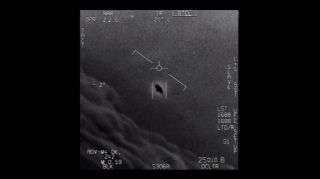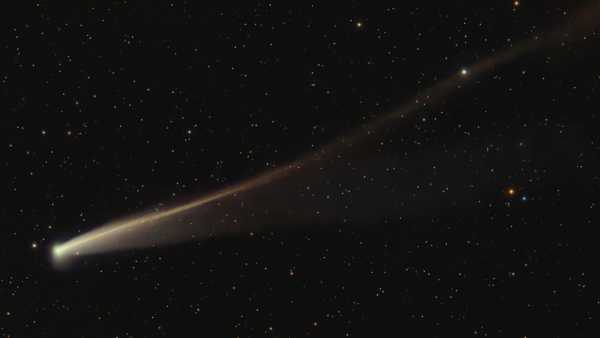
U.S. Navy videos of alleged UFO sightings were previously available but had not been officially declassified.
If you’re a fan of unidentified flying objects (UFOs) and alien visitation, this is manna from heaven.
Three videos showing U.S. Navy pilots encountering mysterious, fast-moving objects emerged in 2017 and 2018. The videos were made public due to reporting by The New York Times and efforts by To The Stars Academy, a research, development and media center for cutting-edge science and technology.
One of the UAP videos was taken in November 2004, and the other two were shot in January 2015. All were captured by Navy F/A-18 Super Hornet jets with pilots utilizing Forward-Looking Infrared (FLIR) technology, hardware that detects heat and creates images.
The three released UAP videos are called “Gimbal,” “GoFast” and “FLIR1” (also known as the “Tic Tac” video).
New task force
Last week, the U.S. Department of Defense (DoD) announced the creation of a task force to analyze and understand the “nature and origins” of UAPs. The Department of the Navy, under the cognizance of the Office of the Under Secretary of Defense for Intelligence and Security, will lead the Unidentified Aerial Phenomena Task Force (UAPTF).
The mission of the UAPTF “is to detect, analyze and catalog UAPs that could potentially pose a threat to U.S. national security,” DoD officials said in a brief statement released on Friday (Aug. 14).
But before you set up greeting signs and start tossing out welcome mats for the incoming aliens, a little perspective and context are in order. I asked some UFO specialists what they thought of the newly announced task force.
Cautiously optimistic
“The formation of a task force on UFOs is another welcome development in the recent renewed interest and attention to these reports by government agencies and political actors,” said Mark Rodeghier, president and scientific director of the J. Allen Hynek Center for UFO Studies in Chicago.
Without further details, it’s impossible to judge how well-positioned the task force will be to seriously investigate reports, Rodeghier added, “but I remain cautiously optimistic for now.”
Rodeghier said he understands the need for secrecy. However, “I would hope that as much information as possible is released to the public so we can all be informed on this potentially world-shattering subject,” he told Inside Outer Space.
Reasons for the DoD to care
“I have no doubt that military intelligence services around the world have always been interested in ‘UFO reports’ — whether or not a real ‘unexplainable’ phenomenon is behind a few of them.”
That’s the view of Jim Oberg, a noted space journalist, historian and a debunker of a slew of UFO sightings. He’s an admitted “lifelong space nut” and professional rocket scientist whose career includes 20-plus years at NASA’s Johnson Space Center in Houston.
There are many non-extraterrestrial reasons why the Defense Department is interested in UFO reports, Oberg said.Not open-ended and ongoing
“I don’t think this [task force] is as significant as some people are suggesting,” said writer and UFO skeptic Robert Sheaffer. “It’s just a response to all the publicity generated by To The Stars leaking the three Navy infrared videos, which the Pentagon later released.”
In the military, a task force is something that is put together to deal with a specific situation or problem, Sheaffer said. It is expected to produce a report and recommendations concerning that issue and is disbanded when such work is complete.
“So, this is not something open-ended and ongoing, like Project Blue Book. It does not suggest an ongoing government interest in unidentified objects,” Sheaffer observed. Conducted by the United States Air Force, Project Blue Book appraised the UFO situation starting in 1952 and officially closed down in 1970.
Intruding into their sandbox
Military operations areas (MOAs) are clearly designated on aviation maps, and civilian aircraft are generally supposed to avoid them, Sheaffer pointed out.
Most of the recent Pentagon comments about “unidentified objects” mention “range incursions,” Sheaffer added — i.e., unknown objects that seem to be entering one of these MOAs.
“So, it seems that the military is worried about unidentified objects that might be intruding into their sandbox. If unidentified objects turn up elsewhere, the military doesn’t care,” Sheaffer said. “The ‘Tic Tac’ and ‘Gimbal’ videos appear to show distant jets, which are probably well outside the MOA, quite far away. The military is investigating out of an abundance of caution, and a sensitivity to criticism.”
Temper expectations
Sarah Scoles is author of the recently published book, “They Are Already Here: UFO Culture and Why We See Saucers” (Pegasus Books, 2020).
“First, I’d say that the establishment of a task force to investigate and understand UAP makes sense and could, if done systematically and scientifically and transparently, provide data useful in interpreting pilots’ sightings,” Scoles told Inside Outer Space.
And it also makes sense, she said, that the Department of Defense — whose job it is, of course, to protect the U.S. from threats — is undertaking this endeavor.
“However, I think those expecting big, exotic conclusions from the task force would do well to temper their expectations,” Scoles said. “If you look at what the official announcement actually says, it’s not quite as extraordinary as it might seem at first glance.”
Boundary-crossing objects
Last week’s three-paragraph DoD release, Scoles added, uses language similar to that of other, previous statements about UAPs. For example, a September 2019 statement from Joseph Gradisher, spokesman for the deputy chief of naval operations for information warfare defining “UAP,” reads, “The ‘Unidentified Aerial Phenomena’ terminology is used because it provides the basic descriptor for the sightings/observations of unauthorized/unidentified aircraft/objects entering/operating in the airspace of various military-controlled training ranges.”
Scoles said that “UAP” technically could include aircraft or objects that are simply unauthorized, as well as aircraft or objects that cannot be immediately identified. “That means that, if a pilot sees something they cannot explain, but someone else explains it a few hours later, it could still fall under the definition of UAP.”
The task force press release uses very similar wording to talk about DoD interest.
“It very specifically states that the DoD is concerned with boundary-crossing by objects that are — right when an observer sees them — unidentified,” Scoles said. “It says nothing so specific about objects that remain forever unidentified and mysterious. It certainly says nothing nor implies anything about alien aircraft.”
But, like all things UFO, Scoles concluded, “vague and somewhat weaselly wording leaves enough room for people to interpret this latest development very differently.”
Leonard David is author of “Moon Rush: The New Space Race” (National Geographic, 2019). A longtime writer for Space.com, David has been reporting on the space industry for more than five decades. Follow us @Spacedotcom, Facebook or Google+. This version of the story published on Space.com.
Sourse: www.livescience.com





